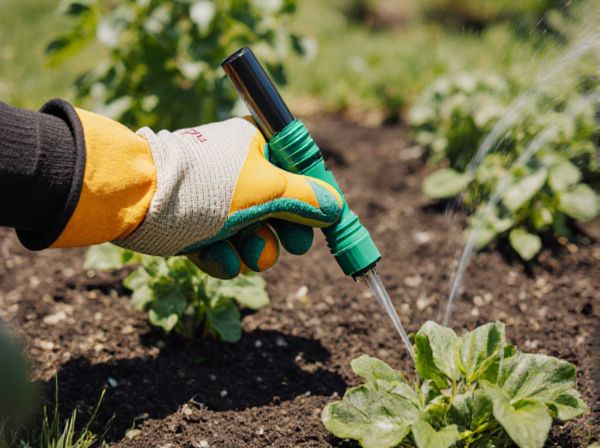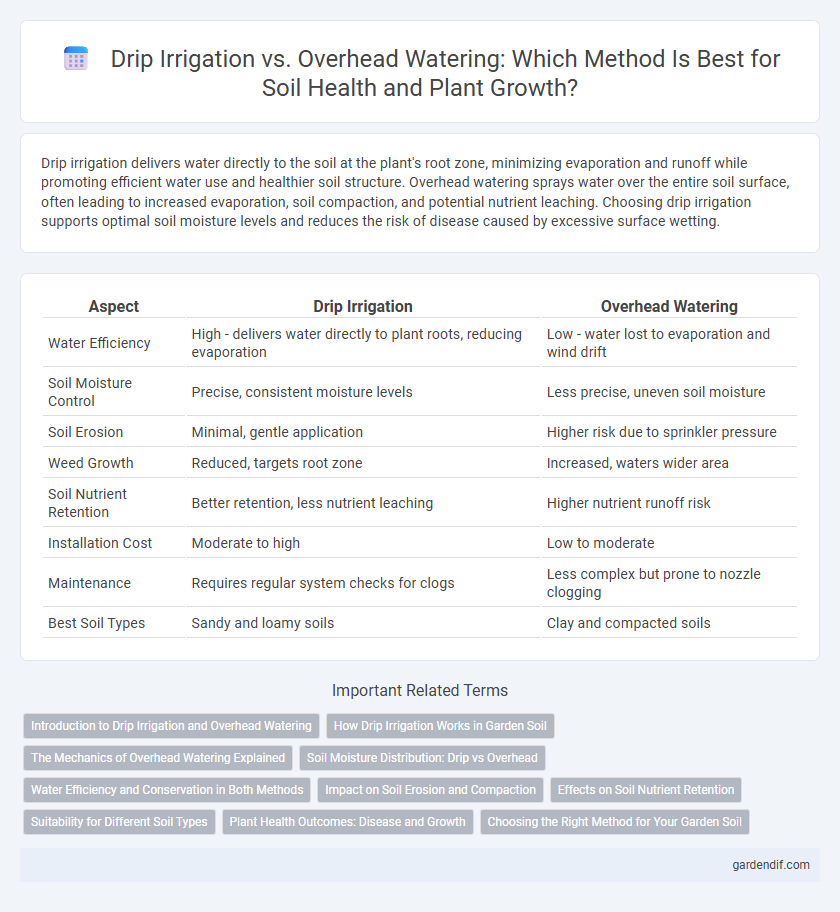
Drip irrigation vs Overhead watering Illustration
Drip irrigation delivers water directly to the soil at the plant's root zone, minimizing evaporation and runoff while promoting efficient water use and healthier soil structure. Overhead watering sprays water over the entire soil surface, often leading to increased evaporation, soil compaction, and potential nutrient leaching. Choosing drip irrigation supports optimal soil moisture levels and reduces the risk of disease caused by excessive surface wetting.
Table of Comparison
| Aspect | Drip Irrigation | Overhead Watering |
|---|---|---|
| Water Efficiency | High - delivers water directly to plant roots, reducing evaporation | Low - water lost to evaporation and wind drift |
| Soil Moisture Control | Precise, consistent moisture levels | Less precise, uneven soil moisture |
| Soil Erosion | Minimal, gentle application | Higher risk due to sprinkler pressure |
| Weed Growth | Reduced, targets root zone | Increased, waters wider area |
| Soil Nutrient Retention | Better retention, less nutrient leaching | Higher nutrient runoff risk |
| Installation Cost | Moderate to high | Low to moderate |
| Maintenance | Requires regular system checks for clogs | Less complex but prone to nozzle clogging |
| Best Soil Types | Sandy and loamy soils | Clay and compacted soils |
Introduction to Drip Irrigation and Overhead Watering
Drip irrigation delivers water directly to the soil near plant roots through a system of tubes and emitters, minimizing evaporation and runoff while enhancing water efficiency. Overhead watering distributes water from above via sprinklers or sprays, covering larger areas but often resulting in higher water loss due to evaporation and drift. Understanding these methods is crucial for optimizing soil moisture management and promoting sustainable agricultural practices.
How Drip Irrigation Works in Garden Soil
Drip irrigation delivers water directly to the root zone of plants through a network of tubes and emitters, minimizing evaporation and runoff in garden soil. This targeted watering method maintains optimal soil moisture levels by slowly releasing water, promoting deeper root growth and reducing weed proliferation. Efficient water use with drip irrigation improves soil structure and nutrient uptake compared to the broad, less precise application of overhead watering systems.
The Mechanics of Overhead Watering Explained
Overhead watering applies water through sprinklers or spray heads that simulate natural rainfall, distributing moisture uniformly across the soil surface. This method can lead to higher evaporation rates and uneven soil saturation, especially in windy conditions, reducing irrigation efficiency. The mechanics involve water droplets impacting the soil, which can cause surface crusting and runoff, affecting soil aeration and root water absorption.
Soil Moisture Distribution: Drip vs Overhead
Drip irrigation delivers water directly to the soil near plant roots, resulting in precise soil moisture distribution with minimal evaporation and runoff. Overhead watering disperses water broadly, often leading to uneven soil moisture levels and increased surface evaporation. Effective moisture management with drip systems enhances soil aeration and reduces water wastage compared to traditional overhead methods.
Water Efficiency and Conservation in Both Methods
Drip irrigation delivers water directly to the root zone, reducing evaporation and runoff, resulting in water use efficiency of up to 90%. Overhead watering typically wastes 30-50% of water through evaporation and wind drift, making drip systems more suitable for water conservation. Soil maintains optimal moisture levels longer with drip irrigation, promoting healthier plant growth and reducing the frequency of watering cycles.
Impact on Soil Erosion and Compaction
Drip irrigation delivers water directly to the soil surface, significantly reducing soil erosion by minimizing runoff and preserving soil structure. Overhead watering often causes surface runoff and can lead to soil compaction due to heavy water droplets impacting the soil, which decreases infiltration and aeration. Choosing drip irrigation supports healthier soil by maintaining porosity and preventing nutrient loss caused by erosion and compaction.
Effects on Soil Nutrient Retention
Drip irrigation enhances soil nutrient retention by delivering water directly to plant roots, minimizing nutrient leaching and evaporation losses compared to overhead watering. Overhead watering often causes surface runoff and nutrient displacement, reducing soil fertility and increasing the risk of erosion. Precise moisture control in drip irrigation promotes microbial activity and nutrient availability, improving overall soil health and plant growth.
Suitability for Different Soil Types
Drip irrigation provides precise water delivery, making it ideal for sandy soils with low water retention by minimizing runoff and evaporation. Overhead watering suits clay soils better as it ensures even moisture distribution, preventing waterlogging and promoting soil aeration. Selecting the appropriate irrigation method depends on soil texture and drainage characteristics to optimize plant health and conserve water.
Plant Health Outcomes: Disease and Growth
Drip irrigation significantly reduces the risk of fungal diseases by minimizing leaf wetness and water contact, promoting healthier root systems and improved nutrient uptake. Overhead watering often increases humidity and leaf moisture, creating favorable conditions for pathogens like powdery mildew and blight, which can stifle plant growth. Consistent moisture delivery from drip systems enhances root development and plant vigor, resulting in higher yields and resilient crops.
Choosing the Right Method for Your Garden Soil
Drip irrigation delivers water directly to the root zone, reducing evaporation and runoff, making it ideal for sandy or loamy soils that require consistent moisture. Overhead watering, while effective for covering larger areas quickly, can increase soil erosion and promote fungal diseases in clay-heavy or poorly drained soils. Understanding soil texture and drainage helps determine the optimal irrigation method, ensuring healthier plant growth and efficient water use.
Drip irrigation vs Overhead watering Infographic

 gardendif.com
gardendif.com